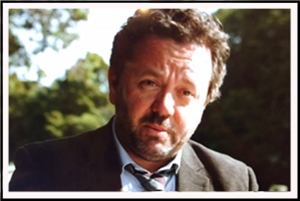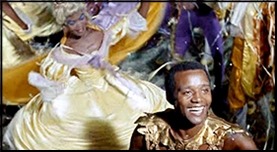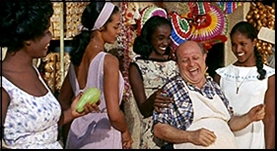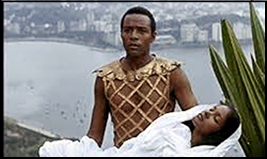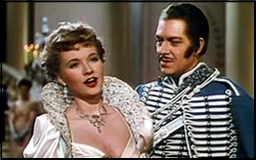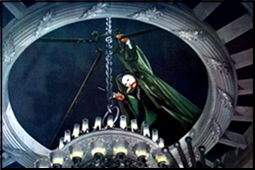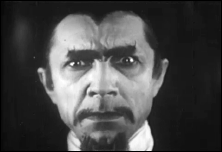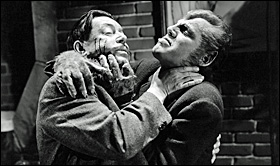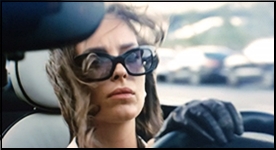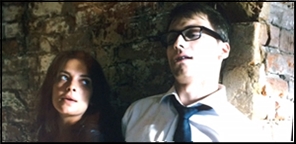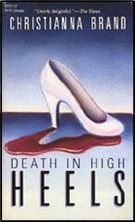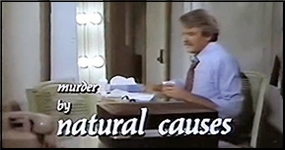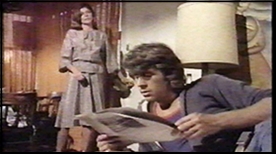Mon 2 Nov 2020
Mike Nevins on Mystery Writer JONATHAN LATIMER.
Posted by Steve under Authors , Columns , Reviews[7] Comments
by Francis M. Nevins
We never met but once we came close to having a conversation. It was the late Seventies, and I was in La Jolla to attend the annual meeting of the University of California library board on which I served. He lived in the same town, and I was given his phone number and tried to call him one evening. His wife answered, saying he literally couldn’t talk with me: he’d just gotten out of the hospital after surgery for throat cancer. That was as close as I came to contact with Jonathan Latimer.
If you watched PERRY MASON regularly during its first-run years on TV (1957-66) you saw his name in the credits again and again. Erle Stanley Gardner is said to have called him the only writer who really mastered the art of writing MASON scripts. Between the second of the show’s ten seasons (1958-59) and its last (1965-66) he wrote a total of 32 hour-long scripts for the series: 25 originals, 6 adaptations of Gardner novels and, I kid you not, one script based on a short story by Hugh Pentecost. But that was the tail end of his career. Our main concern here is with his beginning.
He was born in Chicago on 23 October 1906 and named Jonathan after his great-great-grandfather, who had served on George Washington’s staff during the Revolutionary War. After graduating from Knox College (Galesburg, Illinois) in 1929 he returned to Chicago and worked as a crime reporter for the Herald-Examiner and the Tribune, meeting several celebrity gangsters while on the job. He was in his late twenties when he began writing novels, the first six published by Doubleday Crime Club, five of them featuring a private detective and somewhat under the influence of the overwhelmingly dominant author of that genre during the 1930s, Dashiell Hammett. The first of these was MURDER IN THE MADHOUSE (1935).
It opens inside an ambulance with a guy named William Crane in handcuffs and being transported through upstate New York to a private sanitarium for well-to-do mental cases. No sooner has he arrived than he seems to establish why he’s there by claiming to be a famous detective, no less in fact than C. Auguste Dupin.
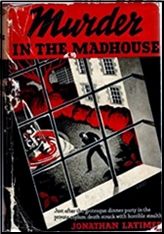
The kicker is that he really is a detective, a PI hired to infiltrate the sanitarium and look into the claim of one of its residents, a dotty old lady who loves to knit, that a box containing negotiable bonds worth $400,000 — a huge amount back in the days when gasoline cost 11 cents a gallon — has vanished from her room. (If you’re wondering why she kept that fortune unprotected, well, didn’t I tell you she was dotty?)
The inmates of this nameless loony bin, whom Crane quickly meets and begins to interact with, include a fellow who thinks he’s Abraham Lincoln, a wolf man who prowls around the grounds on all fours, another guy who hasn’t spoken a word in four years, and several more, perhaps a few too many. The doctors in charge are at each other’s throats, most of the nurses are predatory sexpots in starched whites, and the staff is mainly composed of weirdoes like the religious maniac who acts as night watchman.
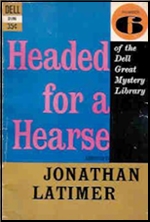
As per the title, there is a murder in the madhouse, four of them in fact. The local law enforcement people are idiots, but there are genuine clues to follow and Crane does a neat job of reasoning in between hearty slugs of the local applejack.
Like Hammett’s Continental Op, Crane is not a lone wolf but works for a big agency, its head being an unseen character known as the Colonel (later expanded to Colonel Black). Unlike the Op, he doesn’t narrate his own cases. But Latimer’s style consists mainly of simple declarative sentences such as we find in Hammett’s THE MALTESE FALCON and THE GLASS KEY. And Crane, like Nick Charles in THE THIN MAN, drinks gallons of booze.
What Latimer contributes to these established ingredients is a sardonic gallows humor whose like is not found in Hammett. We don’t find a great deal of this in MURDER IN THE MADHOUSE but it soon becomes prominent.
Like Sam Spade in THE MALTESE FALCON and Ned Beaumont in THE GLASS KEY, Crane was onstage at every moment of MADHOUSE, but his next case features several scenes without him. In HEADED FOR A HEARSE (1935) he’s still based in New York but spends almost all of his time in Chicago, racing against the clock to save an innocent man from the electric chair. Joan Westland was found shot to death in her locked apartment, to which only she and her estranged stockbroker husband Robert had keys.
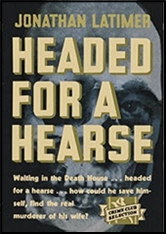
There’s no murder weapon on the scene but ballistics tests establish that the fatal bullet came from a rare British pistol of World War I vintage. Robert owned such a pistol, which has mysteriously vanished. The people in the apartment below Joan’s testify that they heard a shot at a time when by his own admission Robert was visiting her.
He’s convicted and sentenced to death, but shortly before his execution he receives a note, apparently from a criminal prowling in Joan’s apartment building at the time of the murder, who claims he can prove Robert’s innocence. With less than a week before his date with the chair, Robert brings in a sleazy criminal lawyer named Finklestein, who in turn brings in Crane.
As in MURDER IN THE MADHOUSE, our PI spends many hours guzzling the sauce as more bodies pile up but somehow manages to get sober for the denouement two hours before Westland is to be fried. The plotting is tight and the solution to the locked-room puzzle pretty simple by John Dickson Carr standards but rather ingenious, although the tie-buying clue and the telephone-call gimmick still leave me scratching my head.
The most powerful scenes take place in the death house at the beginning and end of the novel. In Chapter XI comes a pure specimen of Latimer’s gallows humor as we get a description of a Bascom Wonder Funeral, “including a handsome Lincoln hearse, three automobile loads of mourners (we can augment your mourners if you desire), the use of our private chapel with the $8000 Barton organ and the Golden Isle Quartette,†plus “a choice of five distinctive caskets.†All for the low low price of $217!

Those not at home in the geography of the Windy City can have a lot of fun with a map tracking Crane’s taxicab journeys back and forth across the Chicago River from Point A to Point B in search of the vanished pistol. But I must warn potential readers that, its merits as a whodunit to one side, HEARSE is a generous anthology of political incorrectness, with epithets taboo in the 21st century strewn all over the landscape: Heeb, sheeny, Chink, dago, even the six-letter word which I’d be screamed at as a racist if I repeated.
All this is okay when coming from the mouths of characters of the Archie Bunker ilk but not so okay in the early pages of Chapter IX when it seeps into the third-person narrative. Small wonder that HEARSE didn’t appear in paperback until more than twenty years after its hardcover publication and then, like another Latimer novel we’ll discuss eventually, only in bowdlerized form (Dell pb #D1896, 1957).
Two years after its publication HEARSE became the basis of the first in Universal Pictures’ 8-film Crime Club series. THE WESTLAND CASE (1937) was directed by industry old-timer Christy Cabanne (1888-1950) from a screenplay by Robertson White. Preston Foster played Crane, with Frank Jenks as his sidekick Doc Williams.
I can’t recall ever seeing this picture but from what I’ve read on the Web (including Dan Stumpf’s review for Mystery*File) it seems to have followed Latimer’s plot fairly closely, although I’m willing to bet that none of the racial and ethnic epithets with which the novel abounds survived into the movie.
In his first two books Latimer tried his hand at the whodunit laced with gallows humor but the next one was his masterpiece in that vein. In THE LADY IN THE MORGUE (1936) New York is still Crane’s base but while temporarily in Chicago he receives a wire from his boss, Colonel Black, directing him to hang out at the Cook County morgue and try to identify the body of an attractive blonde who apparently hanged herself in her cheap hotel room right after taking a bath and disposing of all her shoes. (As we learn later, the firm has been hired by members of a wealthy family who are afraid the dead woman might be the clan’s rebel daughter.)
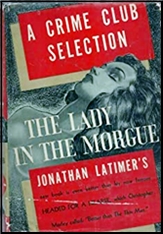
But the body is stolen from the morgue during the wee hours and the night attendant bludgeoned to death. The hunt for the missing corpse soon leads to the murder of an undertaker and a wave of wacky-gruesome incidents as Crane and his sidekicks Doc Williams and Tom O’Malley encounter a pair of feuding gangsters, a gaggle of luscious blondes, and an alcoholic bulldog in whose company they conduct a midnight search of a cemetery for another (or is it the same?) vanished female body.
Crane finds little time to sleep but plenty to guzzle — including a slug of embalming fluid unaccountably kept in a bottle of Dewar’s Scotch — as he and his buddies lurch from one cockeyed venue to another, perhaps the most vivid being the dime-a-dance joint where all the girls dance in their underwear and the morgue where Crane wraps himself in a sheet and, posing as an embalmed corpse, waits for the murderer.
The solution is chaotic and what passes for reasoning leaves much to be desired, but what a madcap epic! In his entry on Latimer in 20th CENTURY CRIME AND MYSTERY WRITERS (3rd ed. 1991) Art Scott calls it “a genuine mystery classic….grotesque and hilarious at the same time, a masterpiece of black comedy.â€
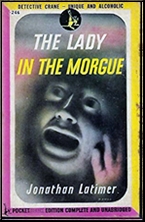
That may be too thick a coat of encomium, but if you’re going to read any Latimer at all it’s gotta be THE LADY IN THE MORGUE. Note for the triviac: In the first edition the drug best known as pot is rendered as marahuana, a spelling I’ve never seen before, but in Crime Club’s hardcover reprint of 1953 it’s changed to the form we all know and love.
Under the novel’s title but without much resemblance to its anarchic plot, THE LADY IN THE MORGUE (1938) became the third entry in Universal’s series of Crime Club movies, with Preston Foster returning as Crane. This one was directed by Otis Garrett, who had served as film editor on THE WESTLAND CASE, with screenplay by Eric Taylor and Robertson White.
A copy of the movie accessible on YouTube shows us that the man claiming to be the vanished corpse’s brother was portrayed by Gordon Elliott, who later in 1938 started going by Bill or Wild Bill Elliott and, under these monickers, quickly become a notable star of B Western flicks.
No novel under Latimer’s byline appeared in the year after MORGUE but a novel by Latimer did. THE SEARCH FOR MY GREAT-UNCLE’S HEAD (1937) was published as by Peter Coffin, who also serves as first-person narrator (Peter Nebuchadnezzar Coffin, to give him his full name). Anyone who had read an earlier Latimer novel was unlikely to have been fooled by the new byline since the detection is done by none other than Colonel Black from the Crane series.
In his ENCYCLOPEDIA MYSTERIOSA (1994) William L. DeAndrea called it “a weird hybrid of country house cozy and hard-boiled effects.†That’s good enough for me. Sometime soon I’ll explore Latimer’s three final PI novels — two about Crane, the third not.


